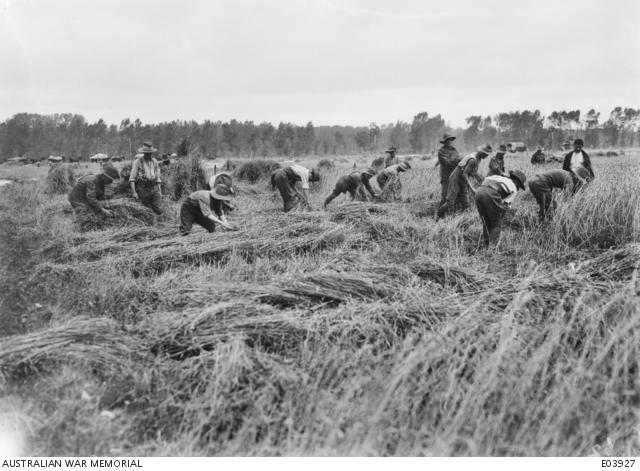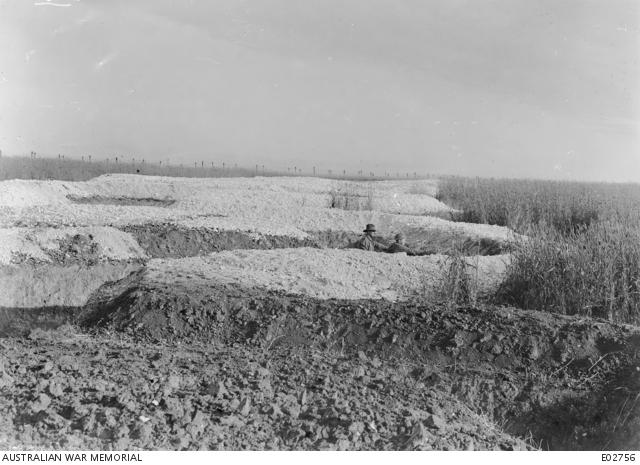Reaping the harvest of war
The First World War may have been the first industrialised war, but a key problem was as old warfare itself – food. Though much of the civilian population in parts of northern France and Belgium had been evacuated, they were replaced with a couple of million of extra mouths, both human and animal. Food processing on an industrial scale enabled armies to subsist on tinned food to varying degrees; but its monotony and nutritional value often led to poor health. Fresh food was needed.
Military facilities such as training camps, convalescent depots and airfields across the UK and France often had large areas of unused ground, which was soon put under cultivation. As well as providing much-needed fresh food to supplement tinned rations, these fields also provided a valuable distraction for idle or recuperating hands.

Members of the Australian Army Service Corps (AASC) working on a potato patch at a camp on the Salisbury Plain.
Photo: C01223, https://www.awm.gov.au/collection/C1001517
Nearer the front, the static nature of trench warfare was both a blessing and a curse. Trench lines that moved little often resulted in the utter destruction of farmland in the contested zone; but land often quite close to the front could be used for growing food and fodder crops. In such stable areas, the civilian population often chose to stay on their farms, well within the sound of the guns.
As the war progressed, it quickly became necessary for the armies, both French and British, to get involved. This became very complicated by the need to work out the many permutations of relations with the landowner: whether the farmer was present, what equipment was there, how much army labour was needed, what crops were available and how much people were to be paid for all this.
Leaving the civilian population to manage their own farms was preferable, but sometimes they needed a hand to gather the harvest; in such cases military personnel resting nearby provided a useful source of labour. Corporal Keith Hickman and some of his colleagues in V3A Heavy Trench Mortar Battery were called to assist in August 1917 while they were resting near Wimereux, north of Boulogne on the French coast:
We were excused parades so that we could help the peasants gather their harvest. Our help was greatly appreciated, and they tried in their way to show their gratitude, by filling us up with Beer & Wine.

Corbie, France. 28 August 1918. Australians of the 10th Brigade harvesting crops during a spell in the rest area.
Photo: E03927, https://www.awm.gov.au/collection/C372972
Some were harsh in their judgement of local practices. Private Lynch of the 55th Battalion who commented in a letter home “They are about ten thousand years behind times. They harvest the wheat with a scythe & in a lot cases thresh it by beating it with a stick or flail.”
Sudden changes in the front line meant a crop sown in a peaceful field could by harvest time be well within rifle shot, let alone artillery range. The German Spring Offensive of March 1918 is the best example of this. Once the advance was halted and the front line settled, fields now untended held ripening crops which should not be wasted. In areas with few or no civilians, the military authorities used whatever equipment and men could be found. Farm machinery in evacuated areas (such as mowers, reapers and binders) was often collected by the authorities to be used when needed. The war diary for the 15th Brigade notes on 22 July 1918 “Cutting of crops proceeded with, two binders being used for this purpose.”

A reaping machine in a wheatfield between Hamelet and Fouilloy.
Photo: E03926, https://www.awm.gov.au/collection/C369551
In many cases the new trench lines went right through fields of crops. This scenario presented a dilemma to the troops in the trenches – the growing crops provided visual cover and even some physical protection from rifle and machine-gun fire, but could allow an enterprising enemy to sneak right up to their trench. (In fact this very tactic became popular with the Australian troops.) To prevent this, crop harvesting was required for the practical military purposes of providing fields of fire and observation. This harvesting was done by hand and at night with sickles, rather than with machines.

Trenches in the Australian Corps Defence System far behind the front lines at Coisy, near Amiens.
Photo: E02756, https://www.awm.gov.au/collection/C962582
The harvested crops were vital for consumption, but they could serve other useful purposes such as camouflage.
The 8th of August was a crucial day in the outcome of the war in France; but while tens of thousands of men were in action on what the Germans later called ‘the black day of the German army’, some 40 men and 14 wagons went to work only a few kilometres behind the main attack to harvest the crops there. This day was the start of the final period of the war and became known as “the Hundred Days,” culminating in the Armistice on 11 November.

A British Army Lewis gun anti aircraft crew in position in a harvest field in the Amiens.
Photo: H08888, https://www.awm.gov.au/collection/C312566